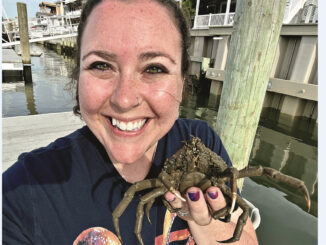
A Flamingo Named Bob
By Kate Hofmann; Photos by Jasper DoestMeet Bob! He’s a flamingo . . . with a job.

Bob looks like a regular flamingo. Long neck. Big curved beak. Beautiful pink feathers. But he is not quite like other birds of his kind. You won’t find him standing around on one leg in a lagoon all day. That’s because Bob is a flamingo ambassador. His job is to help people better understand flamingos.
He and veterinarian Odette Doest travel the Caribbean island of Curaçao (KOOR-uh-sow, see map), teaching both kids and grownups about wild flamingos and how to protect them.

Let’s ask Odette, who knows Bob best, to tell us more about this very unusual flamingo.
How did you meet Bob?
A couple of years ago, he accidentally crashed into a third-floor window at a local hotel. He landed, injured, near the pool. I heard about it and rushed over. I’m a veterinarian for pets, but I also often take care of wild animals that need help.
Why does Bob live with you?
While Bob was recovering, I learned that he was used to being around people and wouldn’t know how to get by on his own in the wild. So he became part of my “rescue flock.” I take care of a number of such birds that can’t be released.
Where did Bob get his name?
I took him to a radio station for an interview I was doing about protecting wildlife. The host (who was quite surprised to see a real flamingo) asked his name. I hadn’t given him one yet, so I just said the first name that came to mind: Bob!
Why is it important for people to learn about flamingos?
There are about 250 flamingos on Curaçao. But most people here don’t know much about them or the things that harm them. For example, flamingos get crowded out of their homes by new hotels and other buildings. And loose dogs can injure or kill them. When people understand flamingos better, they can help protect them.
You and Bob often visit schools to teach about flamingos. What do the students think of Bob?
They want to know all about him! Many have never seen a real, live flamingo up close. A four-foot-tall, bright pink bird makes quite an impression. They ask lots of questions. After meeting Bob, they also begin to think of wild flamingos differently—as Bob’s friends and family members. Bob has quite a fan club!

Do you and Bob go to other places besides schools?
Yes! We go to radio and television stations, and I talk about protecting wildlife. We’ve been to visit scout groups, elderly people, and even the police, coast guard, and fire departments.
Tell us about your work as a veterinarian.
I take care of dogs, cats, and many other pets. Pet birds are my specialty. But I also usually treat four or five injured wild birds each week. My office is next door to my house, and my rescue birds live in my yard and on my porch.
What does Bob do when you’re working at your vet clinic?
Well, Bob sometimes works with me there, too! When new flamingo patients come to my office, they are not only hurt but also scared. Seeing another flamingo helps them feel more at ease. By watching Bob, they learn to accept the food I give them and stay calm while I’m treating them.
How does Bob relax in his free time?
Bob loves to hang out in the special saltwater pool I have in the yard. There’s a shallow side where he can splash, and a deeper side where he can take a swimming lap if he wants to. I do take him to the beach sometimes, and he loves that, too!
Do you think Bob likes being a wildlife ambassador?
Flamingos usually live in big flocks, but I’m not worried that Bob is lonely. He has a buddy named George, another flamingo that can’t be released. And Bob spends time with all the other flamingos that pass through. He is also very comfortable around people. I wish he could go back to the wild, but he is really making a difference for wild flamingos by doing what he does. Thanks to Bob, many more people know how special and amazing flamingos are.
















